Maj7 arpeggios are a must-know concept for any jazz guitarist, but they can be difficult to get under your fingers when working these shapes around the entire fretboard. Finding a system to organize your maj7 arpeggios can make playing and soloing with maj7 arpeggios easy, as you will be able to think less about the shapes of each arpeggio and their location on the neck, and more about how you want to make musical and interesting lines.
In this lesson, you will learn how to build maj7 arpeggios, how to relate maj7 arpeggios to four inversions of maj7 chords, exercises to practice these arpeggios, and a sample application of these shapes to the tune “On Green Dolphin Street.”
What Are Maj7 Arpeggios?
Maj7 arpeggios are four-note shapes that contain the Root, 3rd, 5th, and 7th notes of the major scale. Here is how those intervals look for a G major scale and Gmaj7 arpeggio.
| G Major Scale | G | A | B | C | D | E | F# |
|---|---|---|---|---|---|---|---|
| 1 | 9 | 3 | 11 | 5 | 13 | 7 | |
| Gmaj7 Arpeggio | G | B | D | F# | |||
| 1 | 3 | 5 | 7 |
To help see this relationship, here is a G major scale next to the Gmaj7 arpeggio on the fretboard, where you can see the notes of the arpeggio are directly taken from the related scale fingering.
Listen & Play Along
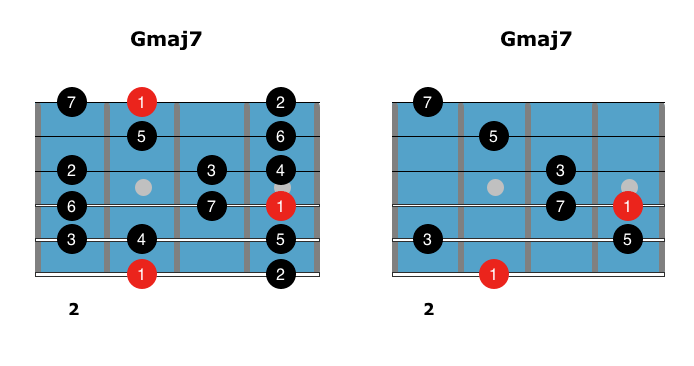
As well, the notes of the Gmaj7 chord are also in the Gmaj7 arpeggio. In this case, you are playing each note once in the chord shape, and not in note order, whereas in the arpeggio, you are playing each note twice to fill both octaves, and they are played in note order as well.
Here are those two items, Gmaj7 chord and arpeggio, side by side for comparison.
| Gmaj7 Chord Shape | G | F# | B | D |
|---|---|---|---|---|
| 1 | 7 | 3 | 5 | |
| Gmaj7 Arpeggio Shape | G | B | D | F# |
| 1 | 3 | 5 | 7 |
And here are those two shapes, Gmaj7 chord and arpeggio, on the fretboard for comparison.
Listen & Play Along
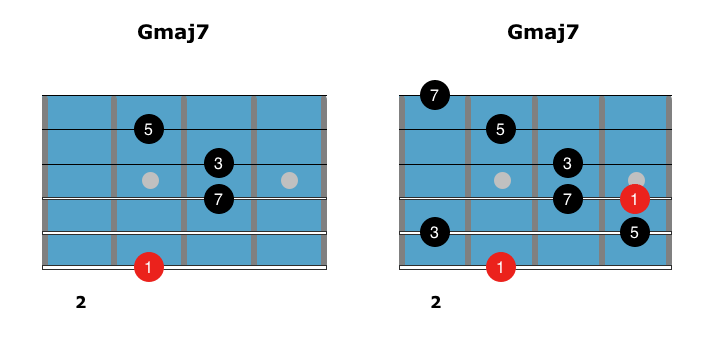
With these comparisons on paper, try playing major scales and chords from different root notes, followed by the related arpeggio shape to see how these items are related on the fretboard before moving on to the next step in the lesson.
Major 7 Arpeggio Fingerings
When learning how to play maj7 arpeggios, one of the easiest ways to cover the fretboard is to relate arpeggios shapes to chord shapes.
This means that for each inversion of a maj7 chord you learn, you learn an arpeggio in that same area.
If you learn maj7 arpeggios in this fashion, you will be able to cover the whole fretboard with chord tones when soloing, as well as always have a chord shape and arpeggio shape under your fingers for any maj7 change you are playing over, which can be very helpful in any jazz guitar situation.
Now that we’ve looked on relating chords to arpeggios, you can now move on to learning these four inversions on the guitar, relating each maj7 arpeggio to an inversion of a maj7 chord.
To begin, here is a root position Gmaj7 chord with a Gmaj7 arpeggio built around that chord shape to practice.
Listen & Play Along
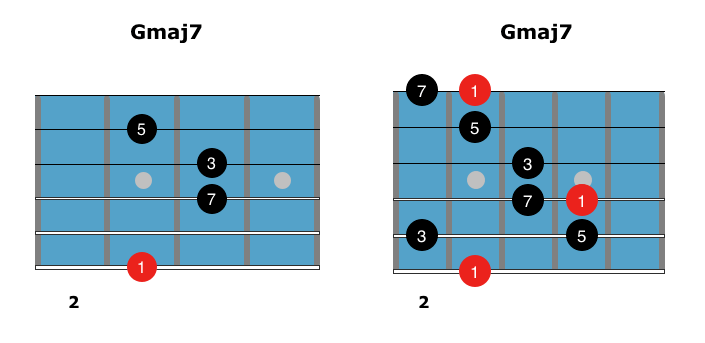
Next, you can learn the 1st inversion of Gmaj7 along with the accompanying arpeggio.
Listen & Play Along
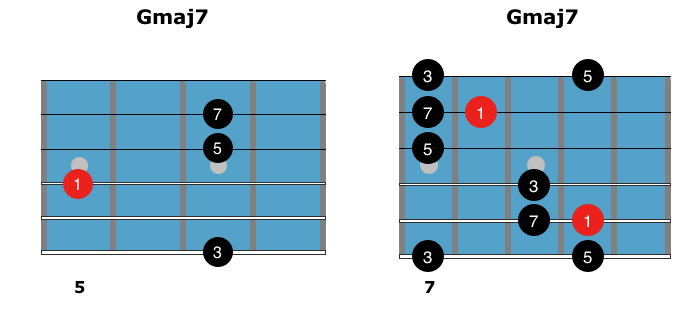
The next shapes are based on the 2nd inversion of Gmaj7 along with an arpeggio built around that chord shape.
Listen & Play Along
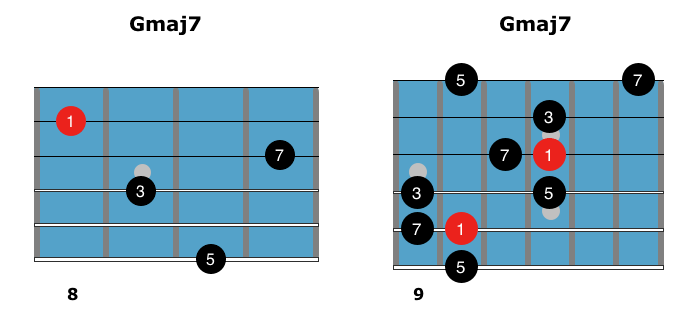
The final shapes are built around a 3rd inversion Gmaj7 chord along with its related arpeggio shape.
Listen & Play Along
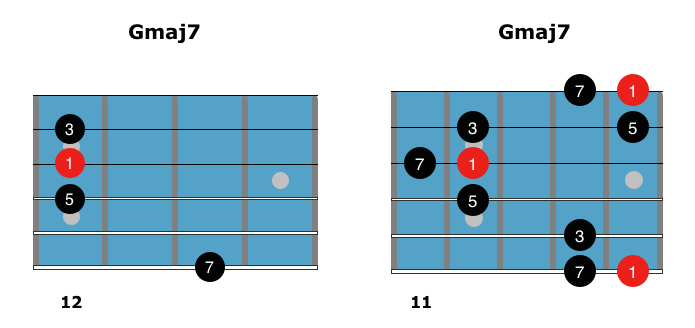
When practicing these chords and arpeggios, make sure to play the chord first followed by the arpeggio. This will make a mental connection between the two shapes and make it easier to switch between chords and arpeggios when you take these shapes to a musical situation.
Major 7 Arpeggio Exercises
Now that you have explored the four maj7 chord-arpeggio shapes in your studies, here is a fun exercise that you can use to work these shapes in all 12 keys while moving to the closest shape each time.
The goal of this exercise is to begin to see the next chord/arpeggio as close to the current chord you are on. So, if you are on Cmaj7 in root position, and want to move to Fmaj7 next, you would play the 3rd position of Fmaj7, which starts on the note C.
Here are the first four chords in this exercise, which we’ll call Group 1, which you will see and hear demonstrated below.
- Cmaj7 – Root Position
- Fmaj7 – 3rd Position
- Bbmaj7 – 2nd Position
- Ebmaj7 – 4th Position
Here are those four chords and arpeggios that you can practice in order to begin expanding these maj7 arpeggios to multiple keys on the fretboard.
Listen & Play Along
Once you have practiced these four shapes with your metronome, you can take them to other keys as you work them around the fretboard.
When doing so, you would get the following 2 groups of 4 arpeggios/chords in each area of the neck.
Group 2
- Abmaj7 – Root Position
- Dbmaj7 – 3rd Position
- Gbmaj7 – 2nd Position
- Bmaj7 – 4th Position
Group 3
- Emaj7 – Root Position
- Amaj7 – 3rd Position
- Dmaj7 – 2nd Position
- Gmaj7 – 4th Position
By working the chords and arpeggios in each of these three groups, the one in the above example and two groups listed after that, you will be able to practice all 12 keys of these arpeggios around the fretboard, while learning how to move between the various arpeggio positions at the same time.
Easy Maj7 Arpeggios – Soloing Sample
To finish your study of Easy Maj7 chords, here is a sample line played over the first 8 bars of the jazz standard “On Green Dolphin Street.” The phrase uses only arpeggios from this lesson to create the line.
Once you have worked out this phrase, try putting on a backing track for these chords, or other groups of Maj7 chords, and creating your own improvised phrases using the arpeggio shapes learned in this lesson.
Listen & Play Along
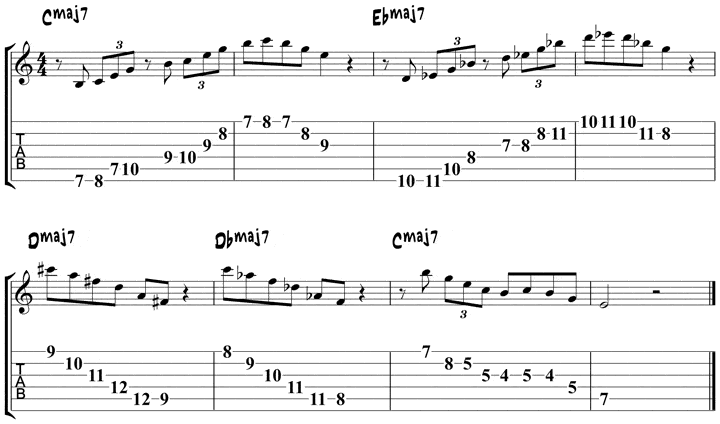

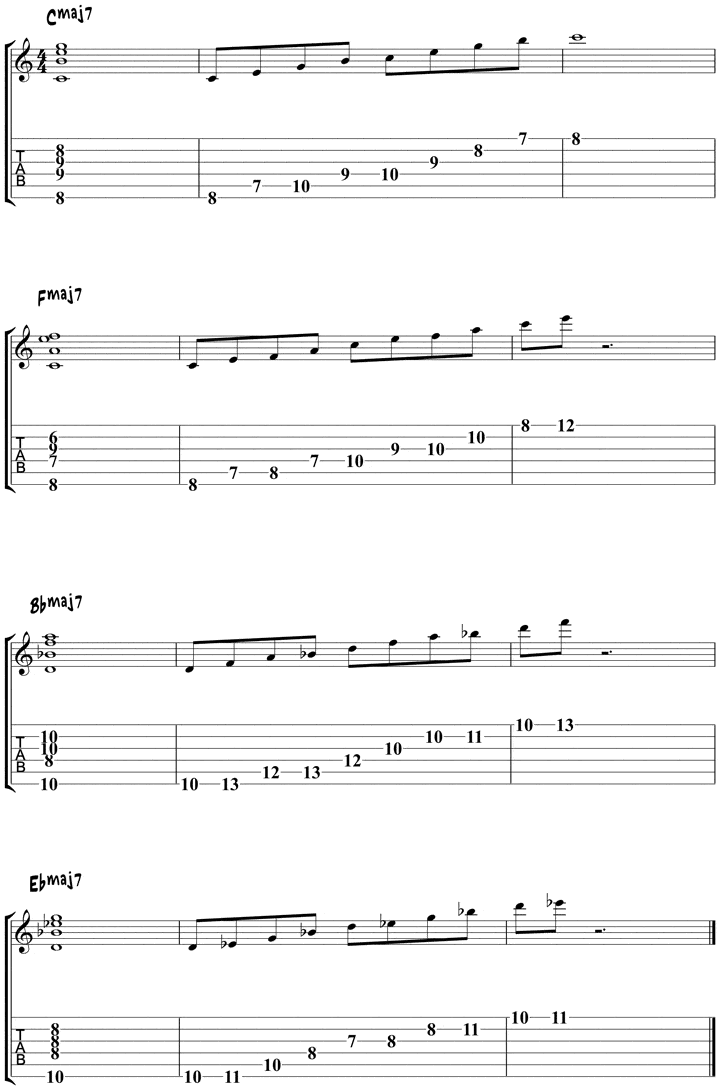

Very doable, would like it in book form.
After listening a while, I encountered that the timing is just as important as the notes. I played the arpeggios but felt that something was missing: timing!
So and for example an D-13 arpegio(D F A C E G B) is équivalent to a C major scale.
This lesson is very important for connections between chords and arpegios. Thanks .
Good lesson Matt.Fills the gaps on fretboard. Thanks.
very good, thanks
Great lesson! Thank you ver y much!
This lesson is so helpful to me. I’m just new to jazz playing (not new to guitar) and your lessons have been foundational to my learning.
Great contributtion to the freedom of soul
Ottima lezione!
This lesson absolutely great. Thank you very much. Are you going to put minor 7 and dominant 7 arpeggioos like this, cause exactly what we need for visualizing and put them together, scales arpeggios and positions, for begginers like me. This is the best lesson I ve ever seen till today among many jazz tutorial sites and blogs. Thank you again
This is all well and good BUT…. All chords get their feeling and sense of direction from Key Structure. Both The Ionian Major 7th and the Lydian major 7th Gmaj.7 & Cmaj.7 (Key of G) are obviously Major seventh chords, but only The Lydian Maj.7 gives you the maj.7b5, +11, not the Ionian Maj.7. Each because of Key Structure. are different animals in their behavior. My problem with what’s being taught here is it’s always presented as individual dissociated tidbits of information. Disregarding key structure as just a another “throw away”.
Hey Dave, I agree that keys are important, which is why these arpeggios are presented as related to the major scale. For lydian, that would be another lesson as it would include mention and study of the #4 note as you said. So the goal of this lesson is to introduce maj7 arpeggios, show how they are built, and relate them to inversions of Maj7 chords. What you mentioned is very important, but just the subject for a different lesson, which we have plans to do in future. Cheers.
This is why Rector always broke a tune down into keys, and the five shapes. All of the arpeggios and chord voicngs are are contained within them. This overview serves me well today. I admit that I know all the arps too, but I hear them, and my fingers find them within the shapes as I hear them as part of a phrase. The overview contains all this stuff. It beats floundering in a sea of bits and pieces of information. I think this is very very important.
Another great lesson Matt, too distracting as always, i’m meant to be doing one thing now i’m going over Maj7 arps instead!
As an aside though, regarding the Maj7 chord inversions, as long as either the root, 3, 5 or 7 is the lowest note in the chord, this would still constitute an inversion, regardless of how the other chord tones are stacked/voiced? it doesn’t have to be strictly:
1,3,5,7
3,5,7,1
5,7,1,3
7,1,3,5
Obviously on the guitar it is difficult to finger some of these voicings, and 7 next to 1 on low strings sounds too weird, so other ways need to be found. It’s just I would have not necessarily called them ‘inversions’, maybe simply ‘other’ voicings.
I’ve never thought about that 2nd inversion shape before (5,3,7,1) so the lesson was worth it just for that!
Yours
Hey, yeah that’s why we use things like Drop 2 and Drop 3 chords. They allow you to play these voicings but you don’t have to break your hands on those crazy stretches!
Thank you very very much! Great lesson
Excellent method for studying and ear training.
I consider that there are seven positions for each scale.
On each note of this scale, one can build a small or big arpeggio.
example:
first position of the CMaj scale = F G A B C D E F G A B C D E F G A
Built on the first degree of the C major scale:
1 little arpeggio CMaj7 = C E G B
2 big arpeggio CMaj7 = G B C B C E G E G
But also small and big arpeggios CMaj, CMaj add9, CMaj6, CMaj6 / 9 CMaj9, CMaj add13, CMaj13.
Do the same thing on the 6 other positions of the C Maj scale (second position of the CMaj scale = G A B C D E F G A B C D E F G A B third etc…).